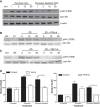Syk-dependent glycolytic reprogramming in dendritic cells regulates IL-1β production to β-glucan ligands in a TLR-independent manner
- PMID: 31509298
- PMCID: PMC6883127
- DOI: 10.1002/JLB.3A0819-207RR
Syk-dependent glycolytic reprogramming in dendritic cells regulates IL-1β production to β-glucan ligands in a TLR-independent manner
Abstract
Dendritic cells (DCs) activated via TLR ligation experience metabolic reprogramming, in which the cells are heavily dependent on glucose and glycolysis for the synthesis of molecular building blocks essential for maturation, cytokine production, and the ability to stimulate T cells. Although the TLR-driven metabolic reprogramming events are well documented, fungal-mediated metabolic regulation via C-type lectin receptors such as Dectin-1 and Dectin-2 is not clearly understood. Here, we show that activation of DCs with fungal-associated β-glucan ligands induces acute glycolytic reprogramming that supports the production of IL-1β and its secretion subsequent to NOD-, LRR- and pyrin domain-containing protein 3 (NLRP3) inflammasome activation. This acute glycolytic induction in response to β-glucan ligands requires spleen tyrosine kinase signaling in a TLR-independent manner, suggesting now that different classes of innate immune receptors functionally induce conserved metabolic responses to support immune cell activation. These studies provide new insight into the complexities of metabolic regulation of DCs immune effector function regarding cellular activation associated with protection against fungal microbes.
Keywords: NOD-, LRR- and pyrin domain-containing protein 3 (NLRP3); dectin-1/2; dendritic cells (DCs); glycolysis; inflammasome; oxidative phosphorylation (OXPHOS); pattern recognition receptor (PRR); spleen tyrosine kinase (Syk); toll-like receptor (TLR).
©2019 The Authors. Society for Leukocyte Biology Published by Wiley Periodicals, Inc.
Conflict of interest statement
The authors declare no conflicts of interest.
Figures





References
-
- Banchereau J, Steinman RM. Dendritic cells and the control of immunity. Nature. 1998;392(6673):245‐252. - PubMed
-
- Lee HK, Iwasaki A. Innate control of adaptive immunity: dendritic cells and beyond. Semin Immunol. 2007;19(1):48‐55. - PubMed
-
- Drummond RA, Brown GD. The role of Dectin‐1 in the host defence against fungal infections. Curr Opin Microbiol. 2011;14(4):392‐399. - PubMed
Publication types
MeSH terms
Substances
Grants and funding
LinkOut - more resources
Full Text Sources
Molecular Biology Databases
Miscellaneous

